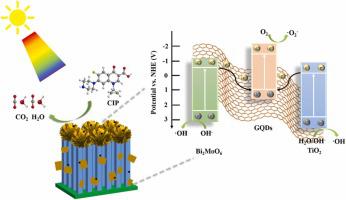Journal of Alloys and Compounds ( IF 5.8 ) Pub Date : 2022-07-28 , DOI: 10.1016/j.jallcom.2022.166533 Yuqing Lu , Chunsheng Ding , Jun Guo , Wei Gan , Peng Chen , Miao Zhang , Zhaoqi Sun

|
There is a high demand for photocatalysts that can efficiently degrade antibiotics; however, there are challenges in technological development related to charge transfer and light capture ability. In this study, ternary Bi2MoO6/GQDs/TiO2 (denoted as BGT; GQDs refer to graphene quantum dots) heterojunction photocatalysts with high ciprofloxacin (CIP) photodegradation efficiency were successfully prepared. BGT with a 0.20 mL GQD dispersion solution (BGT-2) exhibited the highest CIP photodegradation efficiency (90.21 %). The rate constant of BGT-2 was 15.49 × 10−3 min−1, which was 4.01, 4.16, and 9.22 times higher than those of Bi2MoO6/TiO2 (3.86 × 10−3 min−1), Bi2MoO6 (3.72 × 10−3 min−1), and TiO2 (1.68 × 10−3 min−1), respectively. The degradation efficiencies of amoxicillin and tetracycline hydrochloride were 78.98 % and 92.49 %, respectively. The effects of pH values, water sources, and inorganic anions on CIP degradation were systematically explored. In addition, three environmentally friendly degradation pathways were proposed based on liquid chromatography-mass spectrometry (LC-MS) results and the toxicity evaluation of the various intermediates. Testing the optical and electrochemical properties of the catalysts showed that the synthesized dual Z-scheme heterojunctions can significantly improve the light capture ability and reduce the photogenerated electron-hole recombination rate, effectively addressing the challenges encountered with the use of photocatalysts.
中文翻译:

双Z型Bi2MoO6/GQDs/TiO2异质结光催化剂高效光降解环丙沙星:机理分析与途径探索
对能够有效降解抗生素的光催化剂的需求很高;然而,在与电荷转移和光捕获能力相关的技术发展方面存在挑战。本研究成功制备了具有高环丙沙星(CIP)光降解效率的三元Bi 2 MoO 6 /GQDs/TiO 2(记为BGT;GQDs指石墨烯量子点)异质结光催化剂。BGT 与 0.20 mL GQD 分散溶液 (BGT-2) 表现出最高的 CIP 光降解效率 (90.21 %)。BGT-2的速率常数为15.49×10 -3 min -1 ,分别是Bi 2 MoO 6 /TiO 2的4.01、4.16和9.22倍(3.86 × 10 -3 min -1 )、Bi 2 MoO 6 (3.72 × 10 -3 min -1 )和TiO 2 (1.68 × 10 -3 min -1), 分别。阿莫西林和盐酸四环素的降解效率分别为78.98%和92.49%。系统探讨了pH值、水源和无机阴离子对CIP降解的影响。此外,基于液相色谱-质谱(LC-MS)结果和各种中间体的毒性评估,提出了三种环境友好的降解途径。对催化剂的光学和电化学性能测试表明,合成的双Z型异质结可以显着提高光捕获能力,降低光生电子-空穴复合率,有效解决光催化剂使用中遇到的挑战。











































 京公网安备 11010802027423号
京公网安备 11010802027423号